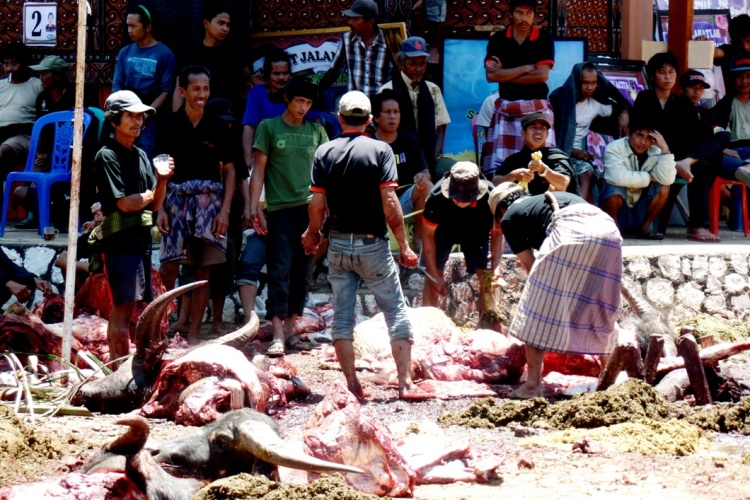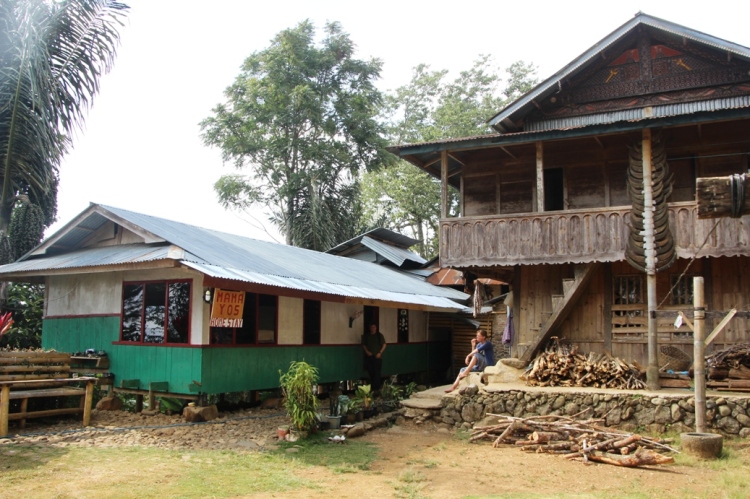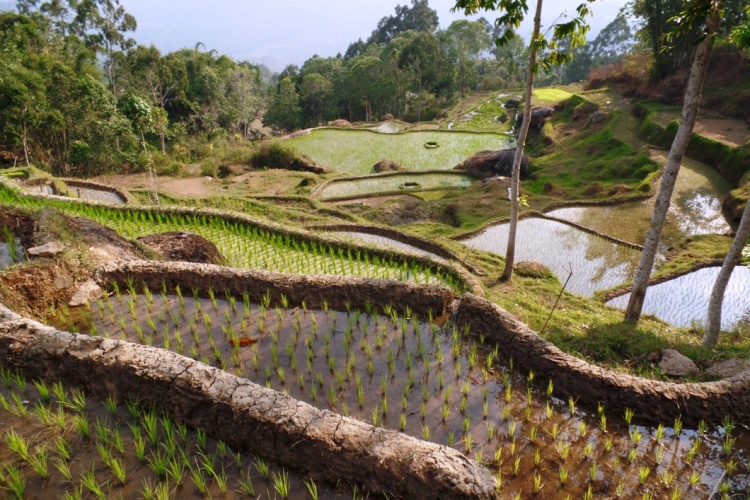29 th October – 3rd November, 2014
Part 1
Following his loss of passport (as well as many other valuables) at the bus station in Makassar, Roy was forced to stay behind while Kate and myself ventured on to Tana Toraja.
It was a real shame, as Sulawesi was probably the part of Indonesia that the three of us had been looking forward to most and it now seemed that Roy was going to miss all its sights. It was also a bit shitty to part with one of my closest friends in such a sudden and downbeat manner. Kate and I weren’t expecting to see him again until, possibly, later that month when we passed through Jakarta – where the nearest British embassy was.
Rantepao, a laidback town nestled between the mountains of Tana Toraja, was where the two of us based ourselves for our first couple of days in the area. Kate was still recovering from a nasty spider bite which got infected and, with her brother no longer with us, I took over the duty of accompanying her on her third visit to the hospital to get the dressing changed.
We didn’t do much else that day. I scouted out the various “Tourist Information” centres, but none of them were willing to reveal to me where any of the tomates (traditional Toraja funerals) were happening or provide me with a map of the area. They were all merely thinly-veiled touts who wanted to sell me tours. I toyed with the idea of going on a multi-day trek, but the price they quoted me when I enquired came loaded with a staggering (and, quite frankly, offensive) amount of White Tax.
These days, when touts quote me ridiculous prices I don’t even bother trying to haggle them down. I just walk away, and hope that they’ll learn that, sometimes, trying to scam foreigners will lose them business.
I did find a map, eventually, and Kate and I spent the rest of the afternoon researching the area. We found out that many of Tana Toraja’s most rewarding trails and sights could be seen without a guide and were near a village called Batutumonga, which itself had a handful of simple, homestay-style accommodation options. So it sounded like a perfect place to base ourselves for a few days.
That night, while eating dinner, I met Dana Rappoport; a French scholar who wrote Songs from the Thrice-Blooded Land: Ritual music of the Toraja, as part of her PhD. It was published over ten years ago but only recently translated into Bahasa Indonesia, and she had returned to Toraja to finally present the book to the tribes-people who helped her write it so long ago.
She spoke very passionately of the Toraja people. I knew a little about them from what I had read and the documentaries I had seen, but during our conversation she fleshed out many of the details for me.
The people of Tana Toraja are mostly known for their peculiar burial customs: when people pass away here their family members will embalm the body and keep it in the house. They will even talk to them occasionally, as if they are still alive. In many ways the deceased are still thought of as alive until the family have gathered enough money and organised the funeral. This can take anything up to ten years.
These funerals – or tomate, as the locals call them – are extravagant and very public events which vary greatly in size and scale but often take place over the space of several days and almost always involve the sacrificial slaughter of dozens of pigs and buffalos.
Most of the population of Toraja call themselves “Christian” these days, but these customs are obviously from something much older. Dana told me, in a regretful tone, how the Toraja people used to have many more beliefs and practices which have now been lost thanks to the efforts of Dutch missionaries and the Indonesian government, who banned most of their rituals until eventually it was only some of their customs surrounding death that they still were still allowed to practice. The Toraja people used to have ways to celebrate life and older gods too, but that has mostly been forgotten now.
When I wandered back to my room later I switched my computer on. I had a message from Roy. It was good news: after spending the day jumping through a series of hoops with the Makassar police and the British consulate, he had been given permission to spend a few weeks in Sulawesi before he reported to the embassy in Jakarta to collect his Emergency Travel Document. He was, as he wrote to me, just about to jump onto the night bus, and would be with us by the morning.
Part 2
Roy arrived the next day bright and early and, after a quick reunion over breakfast, we decided to not waste any more time and find one of those Torajan funerals we had heard so much about. Kate had heard rumours about one taking place in a village called Langda, but we found it impossible to find a bemo heading there: everyone we asked just kept sending us around in circles. We also kept being told about other villages where funerals were supposed to be going on – Londa, Lemo, La’bo – so we decided to get on a bemo which was heading to Lemo.
This turned out to be a mistake: the driver had merely been giving us what I call the “Asian Nod”: a common practice in Asia, where one whom faces the prospect of receiving money from a foreign tourist will simply nod their head and say “yes” to pretty much anything.
“Going to Lemo?”
“Yes.”
“Funeral there, yes?”
“Yes”
“Definitely funeral there. Burial. Yes?”
“Yes.”
Usually, we would have spotted this by implementing a tactic Roy invented; asking a few trick questions, such as, “are there unicorns in Lemo?” and “does the ride come with a free handjob?” to see if they are actually listening – but it was a bit early in the day and I guess we were being sloppy travellers that morning.
As far as mistakes go, it wasn’t a particularly bad one: Lemo was a pleasant village and it was there we saw our first examples of tongkonan (traditional Toraja houses, with boat-like roofs).
We also got talking to some people there and found out about a couple of places where there actually were funerals going on. We then got back onto another bemo, this time heading east. To Sangalla.
Where we found ourselves not walking into the main ceremony, but the bloody aftermath. Dozens and dozens of pigs and buffalos had just been sacrificed and people were in the process of butchering the meat and sharing it out.
I found the level of animal cruelty in Tana Toraja a bit challenging at times. Yet I also felt that I – even though myself a vegetarian – was not in a position to judge them, being from a country where the majority of the meat consumed is battery farmed. Here, in Toraja, the buffalos and pigs at least seem to live fairly comfortable lives until the day they are picked to be sacrificed in a ceremony – after which, they are then unceremoniously strapped to a plank of wood and thrown into the back of a bus (as I witnessed being done several times to pigs at bus stations).
In the “modern” Western world, the meat industry is based upon denialism: factory-farms go to great lengths to stop consumers seeing the conditions animals are kept in, and the sterile, clinical way the meat is then processed, cleaned and packaged before it is sold in the supermarket, doesn’t encourage consumers to think too much about where it actually comes from. We even disassociate it further by giving it names, like “beef”, “pork”, and “venison”. Here, in Asia, at least people know and, more importantly, experience, how their meat is produced.
Later in the afternoon, Roy and Kate were feeling tired so they went back to our room in Rantepao. I ventured off alone and visited Ke’te Ketsu, a very scenic village.
I also went to Palatokke, where a pair of youngsters ran out to greet me. They escorted me up to the face of rocky outcrop overlooking the hills.
It was a burial site; where the bones of their ancestors now rested in hanging coffins, and human skulls had been arranged around various altars.
When I returned to Rantepao later, Roy, Kate and I began to make preparations for the next few days: we packed away a change of clothes and some other essentials into our daypacks and asked our guesthouse if they could store the rest of our things for a few days.
In the morning we were heading to Batutumonga.
Part 3
We left Rantepao by ojek.
Which I believed to have been a good decision: it was much faster, the drivers took us on a shortcut through some roads where buses can’t go, and we got to enjoy sweeping views of Tana Toraja mountains from the back of a bike and feel the wind on our faces.
We were dropped off in Lempo, which was just above some of the rice terraces and was a great place to stop for a while and take photos.
We carried on making our way up the mountain by foot, reaching Batutumonga an hour or so later, where we found suitable accommodation to base ourselves for the next few days: a rustic homestay called “Mama Yos”. We were each given a small room with a mattress on the floor to sleep in, and there was a mandi style bathroom for washing.
That afternoon we walked to Lokomata, a nearby village. The route was along a concrete road but on the way I saw some of the finest views of rice terraces I have ever seen.
Lokomata itself was also very impressive. It was where some of the wealthier Torajan people had been laid to rest in holes which had been slowly chinked away out of the face of a large rock-face.
Just before sundown we made our way back to Batutmonga, and Yos had prepared a small feast for us of rice, vegetables, fried eggs, and tempe. I washed it all down with a Bintang and then retired to my room with a book. I fell asleep very early that night.
Throughout the days which followed we embarked upon a series of short hikes through the majestic landscape of Tana Toraja, and we passed through many terraces, forests, burial sites, and villages along the way. We also came across a few mysterious megalithic stone monuments which could almost have been lifted straight out of Celtic Britain.
With its almost mythical landscape, scattered with large grey boulders, one can see how the generations of natives here might have developed weird, magical, and wonderful customs.
There is something very special about Tana Toraja, and I am certain that it will one of the highlights from my trip around Indonesia.
While staying in Batutumonga, we also wandered into another funeral. This was a bit smaller than the one we saw in Sangalla, but the people were very friendly and welcoming. They took us up to a small room to see the coffin of the deceased and then sat us down in a space usually reserved only for special guests.
They then made conversation with us while supplying endless rounds of coffee. In the background, the butchered remains of sacrificed pigs were being dealt out to guests, and it seemed to go on for hours. We were eventually bequeathed a chunk of pork flesh each ourselves. It was a bit awkward having to then explain to them that the three of us were all, in fact, vegetarian, and had come to merely observe the mass slaughter of animals, but once they understood, there was much laughter.
On the morning of our third day in Batutmonga we sadly had to say goodbye to Yos and her family. We packed our bags, again, and began to make our way back down the mountain by foot.
This trail, out of all the ones we had hiked over the last few days, had the most spectacular views, and we passed through lots of charming villages.
Five hours later we reached Bori. By then we were feeling hot, sweaty, and weary, so, after having a quick look around the village, we hitchhiked the rest of the way back to Rantepao on the back of a truck.
For more photos, feel welcome to visit my Flickr account. I must apologise, for there are quite a lot of them this time. I deleted as many as I could, I promise!























